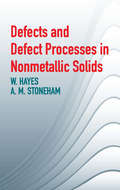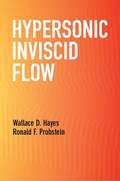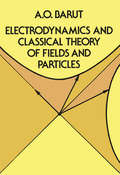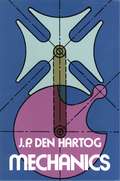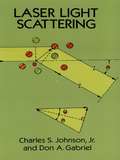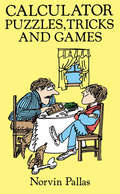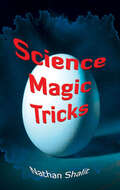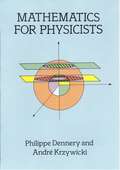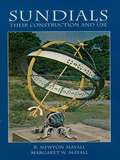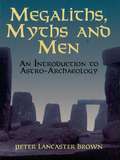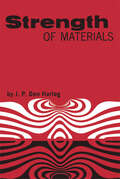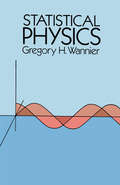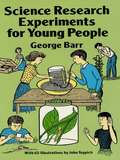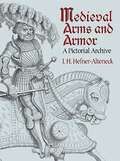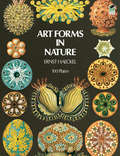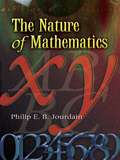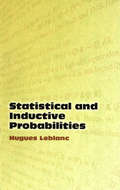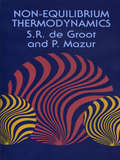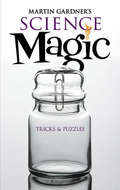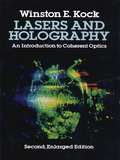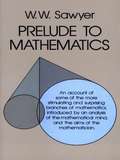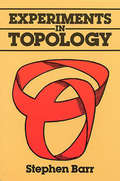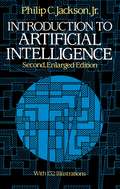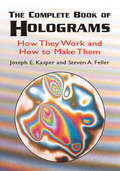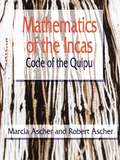- Table View
- List View
Defects and Defect Processes in Nonmetallic Solids
by W. Hayes A. M. StonehamAcclaimed by Nature as "an ideal text," this extensive survey provides coverage of defects in nonmetals, emphasizing point defects and point-defect processes. It encompasses electronic, vibrational, and optical properties of defective solids and discusses extended defects such as dislocations and grain boundaries. 191 figures. 43 tables. 1985 edition.
Hypersonic Inviscid Flow
by Ronald F. Probstein Wallace D. HayesThis treatment of the branch of fluid mechanics known as hypersonic inviscid flow offers a self-contained, unified view of nonequilibrium effects, body geometries, and similitudes available in hypersonic flow and thin shock layer theory. Seeking to cultivate readers' appreciation of theory, the text avoids empirical approaches and focuses on basic theory and related fundamental concepts.Contents include introductory materials and chapters on small-disturbance theory, Newtonian theory, constant-density solutions, the theory of thin shock layers, numerical methods for blunt-body flows, and other methods for locally supersonic flows.Geared toward the needs of students and researchers in the field of modern gas dynamics and those of hypersonic aerodynamics, this text is appropriate for graduate-level courses in hyspersonic flow theory as well as courses dealing with compressible flow.
Electrodynamics and Classical Theory of Fields and Particles (Dover Books on Physics)
by A. O. Barut"We can only hope that more such striking expositions will be written." -- Bulletin of the American Mathematical SocietyThis is a systematic, covariant treatment of the classical theories of particle motion, fields, and the interaction of fields and particles. Particular attention is given to the interaction of charged particles with the electromagnetic field. The treatment throughout the book is relativistic; the author attempts, as much as possible, a coordinate free (or covariant) form of the equations both for particles and the fields. The book opens with an extensive discussion of space-time, Lorentz transformations, Lorentz-group and tensor and spinor fields. This material is essential to the understanding of many branches of theoretical physics, in particular relativistic quantum theory. Chapter II describes various relativistic forms of the fundamental problem of dynamics: describing the trajectories of particles for given external forces. The general dynamical principles to obtain the field equations and the important problems of the conservation laws are discussed in Chapter III. The second part of the book (Chapters IV-VI) is devoted to a lucid treatment of the interactions of fields and particles. Chapter IV deals with equations of motion and their solutions (the so-called Cauchy problem), focusing on the solution of field equations with Green's functions using Dirac formalism. The problem of feedback between particles and fields (radiation and radiation reaction) is taken up in Chapter V, as are questions concerning the limitations of classical field theories and classical dynamics. Dr. Barut concludes the book with an excellent exposition of the purely mechanical approach to the problem of the interactions of charged particles -- the so-called action-at-a-distance formulation of electrodynamics. Problems, alternate proofs, and additional topics are included at the end of each chapter, where a useful bibliography is also provided. A general bibliography appears at the end of the book.
Mechanics
by J. P. HartogFirst published over 40 years ago, this work has achieved the status of a classic among introductory texts on mechanics. Den Hartog is known for his lively, discursive and often witty presentations of all the fundamental material of both statics and dynamics (and considerable more advanced material) in new, original ways that provide students with insights into mechanical relationships that other books do not always succeed in conveying. On the other hand, the work is so replete with engineering applications and actual design problems that it is as valuable as a reference to the practicing engineer as it is as a text or refresher for the general engineering student. Mechanics is not a "heavy" book, despite the amount of material it covers and the clarity and exactness with which it treats this material. It is undoubtedly one of the most readable texts in the field. More than 550 drawings and diagrams in the regular text and in the highly praised 112-page section of problems and answers further contribute to its lucidity and value. The emphasis is consistently on illuminating fundamental principles and in showing how they are embodied in a high number of real engineering and design problems concerning trusses, loaded cables, beams, jacks, hoists, brakes, cantilevers, springs, balances, pendulums, projectiles, cranks, linkages, propellers, turbines, fly ball engine governors, hydraulic couplings, anti-roll devices, gyroscopes, and hundreds of other mechanical systems and devices.Chapters cover Discrete Coplanar Forces, Conditions of Equilibrium, Distributed Forces, Trusses and Cables, Beams, Friction, Space Forces, The Method of Work, Kinematics of a Point, Dynamics of a Particle, Kinematics of Plane Motion, Moments of Inertia, Dynamics of Plane Motion, Work and Energy, Impulse and Momentum, Relative Motion, and Gyroscopes. Particularly in the last two chapters, Den Hartog provides advanced material not usual in introductory texts. "Very thoroughly recommended to all those anxious to improve their real understanding of the principles of mechanics." -- Mechanical World. Index. List of equations. 334 problems, all with answers. Over 550 diagrams and drawings.
Laser Light Scattering: Basic Principles and Practice. Second Edition
by Benjamin ChuGeared toward upper-level undergraduate and graduate students, this text introduces the interdisciplinary area of laser light scattering. It focuses chiefly on quasielastic laser scattering, discussing theoretical concepts at a realistic level.Some background in the physical sciences is assumed, but the opening chapters offer a brief review of classical electricity and magnetism as well as the general scattering theory. Topics include basic theoretical concepts related to light mixing spectroscopy, characteristics of the Fabry-Perot interferometer, and photon-counting fluctuations. The author, a distinguished professor in the Department of Chemistry at Stony Brook University, discusses experimental methods, including setting up a light scattering spectrometer using digital photon-counting and correlation techniques. Subsequent chapters explore applications to macromolecular systems, anemometry and its utility in reaction kinetics, and critical opalescence. References appear throughout the text.
Calculator Puzzles, Tricks and Games (Dover Children's Science Books)
by Norvin PallasPerform amazing feats of mathematical magic, answer clever riddles, and much more with this book and a handy pocket calculator. Scores of brain-teasers, puzzles, mathematical oddities, games, and recreations to fill dozens of hours with fun and excitement. Answers to problems.
Science Magic Tricks (Dover Science For Kids)
by Nathan ShalitThis educational, fun-filled book will show you how to dazzle audiences with dozens of fascinating tricks based on scientific principles. Included are more than 50 safe demonstrations easily performed at home or in the classroom with a ping-pong ball, broom, potato, balloon, coins, playing cards, and other common items. Clear illustrations and simple, easy-to-follow instructions enable you to perform dozens of "tricks" involving mathematics, chemistry, inertia, magnets, optical illusions, and physics. Astound friends and relatives by cutting glass with scissors, inserting a pin in a balloon without popping it, creating a magical doorway out of paper, concocting witch's dust and "wet" fire, practicing the art of secret writing, and successfully accomplishing many other mystifying feats. Best of all, as you entertain audiences with these eye-popping tricks, you'll be learning important scientific facts and principles. These science magic tricks make learning fun!
Mathematics for Physicists (Dover Books on Physics)
by André Krzywicki Philippe Dennery"A fine example of how to present 'classical' physical mathematics." -- American ScientistWritten for advanced undergraduate and graduate students, this volume provides a thorough background in the mathematics needed to understand today's more advanced topics in physics and engineering. Without sacrificing rigor, the authors develop the theoretical material at length, in a highly readable, and, wherever possible, in an intuitive manner. Each abstract idea is accompanied by a very simple, concrete example, showing the student that the abstraction is merely a generalization from easily understood specific cases. The notation used is always that of physicists. The more specialized subjects, treated as simply as possible, appear in small print; thus, it is easy to omit them entirely or to assign them to the more ambitious student.Among the topics covered are the theory of analytic functions, linear vector spaces and linear operators, orthogonal expansions (including Fourier series and transforms), theory of distributions, ordinary and partial differential equations and special functions: series solutions, Green's functions, eigenvalue problems, integral representations. "An outstandingly complete collection of mathematical material of wide application in physics . . . invaluable to the reader intent on increasing his knowledge of the mathematical theories and techniques underlying physics." -- Applied Optics
Sundials: Their Construction and Use
by R. Newton Mayall Margaret W. MayallTo many people, the construction of a sundial implies laborious mathematical calculations and a knowledge of astronomy. Nothing could be farther from the truth. This fascinating handbook, used in conjunction with ordinary tools and materials found around the home, makes it easy to design and construct a sundial on almost any surface and in virtually any position. Introductory chapters offer a wealth of information on the sundial's development from ancient times to the present, why the sundial tells time, how to design and make a dial, and more. These chapters are followed by full instructions on how to construct the hour lines for many kinds of sundials, by the graphic or geometric method. The use of this method doesn't require a knowledge of mathematics or astronomy. It simplicity and accuracy, together with the ease and quickness of delineation, make it very practical. Readers will also find fascinating chapters on dial furniture, portable sundials, constructing a heliochronometer (a highly precise solar timekeeper), sundial classification, and other topics. Accompanying the text are 150 well-chosen illustrations, many published for the first time. They depict scale models, as well as a moon dial, a cathedral dial, and other actual dials from around the world, including the world's largest, in Jaipur, India. If you've ever wanted to build your own sundial, or if you simply want to know more about these ancient timepieces that can show the time of day as accurately as many clocks, this clearly written, easy-to-follow guide is "the best book available." -- Commonweal.
Megaliths, Myths and Men: An Introduction to Astro-Archaeology
by Peter Lancaster BrownAs commonly used, the term "megaliths" refers to huge, free-standing, neolithic stones whose origin and meaning have long been debated by archaeologists and students of prehistory. Perhaps the most famous neolithic site is Stonehenge, the great circle of giant stones on Salisbury Plain in England. Twentieth-century studies of Stonehenge and other megalithic monuments have given rise to the science of astra-archaeology, i.e, the study of early astronomical knowledge through the interpretation of ancient monuments and other archaeological data.The present volume, by a noted British astronomer, provides a unique introduction to this fascinating discipline. The heart of the book is devoted to a detailed study of Stonehenge (six chapters alone), along with scores of equally mysterious megalithic rings and earthworks scattered throughout the British Isles and northwestern France. Enhanced with more than 140 photos, maps, and illustrations, the text examines Stone Age sculpture, astronomical computations, radiocarbon elating, Egyptian pyramidology, Druidic and other folklore, and many other aspects of the topic.Impartial, painstakingly researched, and lucidly written, the text is an "essential summary of astronomy in the Stone Age" (New Scientist) and a "fascinating, up-to-date sourcebook for the layperson and specialist." (Publishers Weekly). Prologue. Introduction. Notes. References. Bibliography. Index. 142 black-and-white illustrations.
Strength of Materials (Dover Books on Physics)
by J. P. HartogAmong introductory texts on the strength of materials, this work is particularly distinguished. It was originally developed by Professor Den Hartog to meet the needs of engineering students at M.I.T. for a sound yet lucid first course in strength of materials. As such it has also enjoyed wide popularity in engineering schools throughout the world.But the book was remarkable in a number of other ways, so that it has become one of the favorite refresher and reference works for engineers as well as a popular self-study text. Perhaps the chief reason for this is that in addition to all the customary elementary material on the subject (i.e., clear instructions to the fundamentals of tension, torsion, bending, compound stresses, deflection of beams, etc.) it also contains a considerable amount of more advanced material concerning methods of great practical value to working engineers which are not usually included in introductory texts. This material is presented in starred sections (which may be omitted on a first reading without interrupting the flow of the presentation) and includes a full treatment of the Mohr circle and its application to the determination of moments of inertia and strains as well as stresses; a lucid elementary presentation of the theory of the center of shear; and one of the few elementary presentations of the theory of the center of shear; and one of the few elementary discussions of the "Myosotis" method of calculating beam deflections, a method which often possesses considerable advantages over the more usual methods involving moment-area or the differential equation of bending.Other material not usually found in elementary texts but which are frequently of great value to the practicing engineer are the discussions of the statically indeterminate truss, reinforced concrete, plastic deformations, thick-walled cylinders, thick curved bars, Maxwell's Reciprocal Theorem, and photoelasticity.In all sections, both general principles and concrete applications are given. Another feature which readers have found unusually helpful is the 85-page section of 350 problems which gives the student practice in techniques and further illustrates applications. All problems are complete with answers.
Statistical Physics (Dover Books on Physics)
by Gregory H. WannierUntil recently, the field of statistical physics was traditionally taught as three separate subjects: thermodynamics, statistical mechanics, and kinetic theory. This text, a forerunner in its field and now a classic, was the first to recognize the outdated reasons for their separation and to combine the essentials of the three subjects into one unified presentation of thermal physics. It has been widely adopted in graduate and advanced undergraduate courses, and is recommended throughout the field as an indispensable aid to the independent study and research of statistical physics.Designed for a one-year course of instruction for non-specialist graduate students, or advanced undergraduates, the book is divided into three parts. Principles of Statistical Thermodynamics (Part I) covers the first and second laws of thermodynamics, elementary statistical methods in physics, and other topics, including an especially clear and enlightening discussion of thermodynamic potentials and their applications. Part II, devoted to equilibrium statistics of special systems, offers excellent coverage of the imperfect gas, lattice dynamics, the statistics of semiconductors, the two-dimension Ising model, and a particularly lucid chapter on dilute solutions. Moreover, the treatment of topics in solid state physics is more extensive than is usually found in books on statistical mechanics. Kinetic theory, transport coefficients, and fluctuations comprise Part III, with a fine presentation of the Kac ring model; the Boltzmann transport equation; kinetics of charge carriers in solids, liquids, and gases; fluctuations and Brownian motion, and more. A liberal quantity of problems has been added to each chapter, including a special section of "recommended problems," whose solutions will insure an adequate understanding of the text. Solutions of all problems will be found at the back of the book along with a list of supplementary literature.
Science Research Experiments for Young People
by George BarrIntriguing, abundantly illustrated collection of 40 experiments to attract and stimulate young minds. Subjects range from electricity and magnetism to weather, water, distance and time. Among the projects: flight testing homemade rocket balloons and tracking electricity around the house.
Medieval Arms and Armor: A Pictorial Archive
by J. H. Hefner-AlteneckA renowned 19th-century cultural historian and specialist on the Middle Ages, J. H. Hefner-Alteneck spent much of his life observing the influence of art on many aspects of human life, including weaponry. His illustrations for this handsome archive — drawn with incredible exactitude — depict a wide array of medieval weapons and armor dating from the early ninth century to the mid-1700s.Adapted primarily from decorative ornamentation on burial monuments and manuscripts, hundreds of finely executed images depict authentic shields, swords, crossbows, helmets, and highly ornate suits of body armor for knights and their steeds. Newly translated descriptive notes, extracted from the original German text, identify the subjects. First published more than 100 years ago, this meticulously rendered study remains an invaluable source of permission-free illustrations for artists and designers and an indispensable reference for scholars, collectors, and hobbyists.
Art Forms in Nature
by Ernst HaeckelErnst Heinrich Haeckel (1834-1919) was renowned as one of the foremost early exponents of Darwinism. His work was credited with having caused the acceptance of Darwinism in Europe, and his popular studies - preaching the continuity of all life, organic and inorganic, from prehistoric time to the present - converted tens of thousands of readers all over the world. Today, although no one is greatly interested in Haeckel the biologist-philosopher, his work is increasingly prized for something he himself would probably have considered secondary. These are the remarkable plates with which his work was illustrated, particularly his famous Kunstformen. The Kunstformen contains 100 beautiful lithographic plates which show a multitude of unusual life forms: Radiolaria, Foraminifera, and other forms of microscopic life; jellyfishes, starfishes, calcareous sponges, star corals, barnacles, and other sea life; mosses, lichens, red algae, ferns, fungi, orchids, and other plants; and turtles, moths, spiders, bats, frogs, lizards, hummingbirds, and antelope. With many drawings on each plate, each carefully drawn from nature, the subtle details of nature's art forms are easily compared and appreciated. In addition to being marvelous renderings, these plates have long been noted for the peculiar emotional appeal that they have for most viewers, a premonition of surrealism with exotic organic life forms stretching back to their roots in the inorganic, and individual details drawn with awareness of subtle evolutionary changes and millennia-long developments. Artists, illustrators, and others will find them still powerful as one of the landmarks of applied art.
The Nature of Mathematics
by Philip E. JourdainAnyone with an interest in mathematics will welcome the republication of this little volume by a remarkable mathematician who was also a logician, a philosopher, and an occasional writer of fiction and poetry. Originally published in 1913, and later included in the acclaimed anthology The World of Mathematics, Jourdain's survey shows how and why the methods of mathematics were developed, traces the development of mathematical science from the earliest to modern times, and chronicles the application of mathematics to natural science.Starting with the ancient Egyptians and Greeks, the author profiles mathematics' rise and progress with the development of analytical methods by Descartes, Galileo, Newton, Leibnitz, and others. The text focuses on principles rather than techniques, exploring the foundations of algebra, analytical geometry, and the method of indivisibles. It discusses the beginnings of the correlation of mathematics and natural science in the study of dynamics as well as the emergence of modern mathematics with the infinitesimal calculus. Additional topics include contemporary views of limits and numbers and a brief summation of the nature of mathematics.
Statistical and Inductive Probabilities (Dover Books on Mathematics)
by Hugues LeblancAmong probability theorists, a bitter controversy has raged for decades between the adherents of John Maynard Keynes' A Treatise on Probability (1921) and those of Richard von Mises' "Grundlagen der Wahrscheinlichkeitsrechnung" (1919). Keynes declared that probabilities measure the extent to which a so-called evidence proposition supports another sentence. Von Mises insisted that they measure the relative frequency with which the members of a so-called reference set belong to another set. Statistical and Inductive Probabilities offers an evenhanded treatment of this issue, asserting that both statistical and inductive probabilities may be treated as sentence-theoretic measurements, and that the latter qualify as estimates of the former.Beginning with a survey of the essentials of sentence theory and of set theory, author Hugues Leblanc examines statistical probabilities (which are allotted to sets by von Mises' followers), showing that statistical probabilities may be passed on to sentences, and thereby qualify as truth-values. Leblanc concludes with an exploration of inductive probabilities (which Keynes' followers allot to sentences), demonstrating their reinterpretation as estimates of truth-values.Each chapter is preceded by a summary of its contents. Illustrations accompany most definitions and theorems, and footnotes elucidate technicalities and bibliographical references.
Non-Equilibrium Thermodynamics
by P. Mazur S. R. GrootThe study of thermodynamics is especially timely today, as its concepts are being applied to problems in biology, biochemistry, electrochemistry, and engineering. This book treats irreversible processes and phenomena -- non-equilibrium thermodynamics.S. R. de Groot and P. Mazur, Professors of Theoretical Physics, present a comprehensive and insightful survey of the foundations of the field, providing the only complete discussion of the fluctuating linear theory of irreversible thermodynamics. The application covers a wide range of topics: the theory of diffusion and heat conduction, fluid dynamics, relaxation phenomena, acoustical relaxation, and the behavior of systems in an electromagnetic field.The statistical foundations of non-equilibrium thermodynamics are treated in detail, and there are special sections on fluctuation theory, the theory of stochastic processes, the kinetic theory of gases, and the derivation of the Onsager reciprocal relations. The implications of causality conditions and of dispersion relations are analyzed in depth.Advanced students will find a great number of challenging problems, with hints for their solutions. Chemists will be especially interested in the applications to electrochemistry and the theory of chemical reactions. Physicists, teachers, scholars, biologists, and anyone interested in the principle and modern applications of non-equilibrium thermodynamics will find this classic monograph an invaluable reference.
Martin Gardner's Science Magic: Tricks and Puzzles (Dover Magic Books)
by Martin GardnerMake an eggshell turn a somersault, spin a coin so that it lands on "heads," teach a bear to climb a string, and perform other acts of scientific wizardry! Martin Gardner, the master of mathematical puzzles, shares more than 80 of his finest magic tricks, teaching children and adults the scientific properties behind water, air, fire, heat, motion, gravity, inertia, friction, electricity, magnetism, sound, and light. Fun and fascinating, the simple maneuvers require only basic everyday props, and those requiring matches, knives, boiling water, and other tricky items are marked with a symbol that lets kids know they'll need assistance from an adult. Helpful drawings illustrate each stunt.
Lasers and Holography
by Winston E. KockAs the words holo (complete) and gram (message) connote, the hologram captures the entire message of a scene in all its visual properties, including the realism of three dimensions. It involves the simple process of photographically recording the pattern formed by two interfering sets of light waves, one of these sets being a reference wave. With the introduction of lasers to holography in 1963, real advances in the development of holography began to take place.Dr. Kock's lucid introduction to lasers and holography has now been revised and updated for a second edition. It begins with a clear discussion of wave patterns and coherence. Then the development of lasers is summarized, along with the phenomenon of wave diffraction. Finally, the important subjects of zone plates and the properties of holograms are skillfully described. A new, concluding chapter brings the story up to the present, with a survey of recent advances in such areas as viewing holograms, hologram computer memories, liquid surface holography, synthetic-aperture radar and sonar, large new lasers, fiber optics, etc. Using language that can be readily understood by high school and junior high school students, Dr. Kock has written a brief, yet authoritative volume that should satisfy anyone's curiosity about this burgeoning field. The remarkable discoveries that have already occurred are only a prelude to an even more remarkable future. 84 illustrations, including 8 new to this edition. New preface. Suggested (1981) additional reading. Index.
Prelude to Mathematics
by W. W. Sawyer"No mathematician can be a complete mathematician unless he is also something of a poet." -- K. WeierstrassIn this lively and stimulating account, noted mathematician and educator W. W. Sawyer (Professor Emeritus, University of Toronto) defines mathematics as "the classification and study of all possible patterns." It is a broad definition, but one that seems appropriate to the great scope and depth of the topic. Indeed, mathematics seems to have few boundaries, either in applications to practical matters or in its mind-stretching excursions into realms of pure abstraction.Gearing his approach to the layman whose grasp of things mathematical may be a bit precarious, Professor Sawyer offers a lucid, accessible introduction to the mathematician's cast of mind. Five well-written preliminary chapters explore the beauty, power and mysticism of mathematics; the role of math as an adjunct in utilitarian matters; and the concepts of pattern, generalization and unification as both tools and goals of mathematical thought.After developing this conceptual groundwork, the author goes on to treat of more advanced topics: non-Euclidean geometry, matrices, projective geometry, determinants, transformations and group theory. The emphasis here is not on mathematics with great practical utility, but on those branches which are exciting in themselves -- mathematics which offers the strange, the novel, the apparently impossible -- for example, an arithmetic in which no number is larger than four.Mathematicians will appreciate the author's grasp of a wide range of important mathematical topics, and his ability to illuminate the complex issues involved; laymen, especially those with a minimal math background, will appreciate the accessibility of much of the book, which affords not only a portrait of mathematics as a matchless tool for probing the nature of the universe, but a revealing glimpse of that mysterious entity called "the mathematical mind." Professor Sawyer has further enhanced this new Dover edition with updated material on group theory, appearing here in English for the first time.
Experiments in Topology
by Stephen Barr"A mathematician named KleinThought the Moebius band was divine.Said he: 'If you glueThe edges of two,You'll get a weird bottle like mine.' " -- Stephen BarrIn this lively book, the classic in its field, a master of recreational topology invites readers to venture into such tantalizing topological realms as continuity and connectedness via the Klein bottle and the Moebius strip. Beginning with a definition of topology and a discussion of Euler's theorem, Mr. Barr brings wit and clarity to these topics:New Surfaces (Orientability, Dimension, The Klein Bottle, etc.)The Shortest Moebius StripThe Conical Moebius StripThe Klein BottleThe Projective Plane (Symmetry)Map ColoringNetworks (Koenigsberg Bridges, Betti Numbers, Knots)The Trial of the Punctured TorusContinuity and Discreteness ("Next Number," Continuity, Neighborhoods, Limit Points)Sets (Valid or Merely True? Venn Diagrams, Open and Closed Sets, Transformations, Mapping, Homotopy)With this book and a square sheet of paper, the reader can make paper Klein bottles, step by step; then, by intersecting or cutting the bottle, make Moebius strips. Conical Moebius strips, projective planes, the principle of map coloring, the classic problem of the Koenigsberg bridges, and many more aspects of topology are carefully and concisely illuminated by the author's informal and entertaining approach.Now in this inexpensive paperback edition, Experiments in Topology belongs in the library of any math enthusiast with a taste for brainteasing adventures in the byways of mathematics.
Introduction to Artificial Intelligence (Dover Books on Mathematics)
by Philip C. Jackson Jr.Can computers think? Can they use reason to develop their own concepts, solve complex problems, play games, understand our languages? This comprehensive survey of artificial intelligence ― the study of how computers can be made to act intelligently ― explores these and other fascinating questions. Introduction to Artificial Intelligence presents an introduction to the science of reasoning processes in computers, and the research approaches and results of the past two decades. You'll find lucid, easy-to-read coverage of problem-solving methods, representation and models, game playing, automated understanding of natural languages, heuristic search theory, robot systems, heuristic scene analysis and specific artificial-intelligence accomplishments. Related subjects are also included: predicate-calculus theorem proving, machine architecture, psychological simulation, automatic programming, novel software techniques, industrial automation and much more.A supplementary section updates the original book with major research from the decade 1974-1984. Abundant illustrations, diagrams and photographs enhance the text, and challenging practice exercises at the end of each chapter test the student's grasp of each subject.The combination of introductory and advanced material makes Introduction to Artificial Intelligence ideal for both the layman and the student of mathematics and computer science. For anyone interested in the nature of thought, it will inspire visions of what computer technology might produce tomorrow.
The Complete Book of Holograms: How They Work and How to Make Them
by Joseph E. Kasper Steven A. Feller"I predict that Kasper and Feller will become a standard reference on holography for students and interested laymen." -- James A. Van Allen.For most nonscientists, holograms are an intriguing -- if not mesmerizing -- mystery. How are these seemingly magical images created and what makes them appear to be three-dimensional? This fascinating book not only offers the answers to these and other questions about holography -- it even gives step-by-step instructions so that readers can manufacture their own holograms.Written in a lively, stimulating style, The Complete Book of Holograms provides a thorough, easy-to-understand explanation of the theory and science of making holograms. The physical basis of holography is introduced through a discussion of interference patterns in water waves and in light waves. Without complicated mathematics or physics, the authors explain the two models of holography -- the geometric and the more complex zone-plate model -- and the several different types of holograms, including transmission, reflection, phase, projection, rainbow, multiplex, and others. They explain how to copy holograms; describe special techniques and applications; and discuss potential uses for holography, including the use of holograms in movies, television, and data storage. They also present some basic setups for making holograms and show readers how to create their own -- using little more than simple photographic equipment and an inexpensive laser. Two appendixes give advice on laser safety and list sources of material and further information.
Mathematics of the Incas: Code of the Quipu
by Marcia Ascher Robert AscherThe Incas of ancient Peru possessed no writing. Instead, they developed a unique system expressed on spatial arrays of colored knotted cords called quipus to record and transmit information throughout their vast empire. The present book is based on a firsthand study of actual quipus that survived the destruction of the Inca civilization. Written by a mathematician and an anthropologist, this book acquaints the reader with the cultural context of the quipus, the problem of interpreting artifacts from another culture, and the place of the quipu-maker in Inca culture. Although no previous mathematical knowledge is assumed, the reader is introduced to the mathematical ideas embedded in the quipus and learns how to make a quipu.Enhanced with over 125 illustrations, this unusual and thought-provoking study will interest mathematicians, historians, anthropologists, archeologists, and students of folk art with its unique perspective on the way in which pieces of colored string serve to embody a rich, logical, numerical tradition and are, ultimately, a metaphor for the civilization that created them. Preface. Exercises and answers within chapters.
